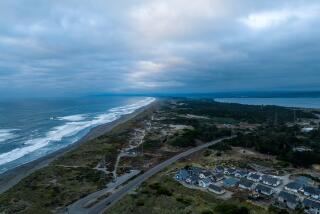On the sunny side of natural disasters
- Share via
Southern California may think of itself as disaster-prone, alternately bemoaning and reveling in its status as earthquake-, wildfire- and mudslide-plagued.
But it seems a reality check is in order: The region is actually one of the nation’s safest -- at least in terms of human lives.
The natural hazards that bedevil us are small potatoes compared with those in other parts of the country, researchers said Wednesday in releasing a disaster map of the U.S.
Extreme heat and cold, flooding and tornadoes are the deadliest natural hazards, and they strike most frequently in the Gulf Coast, the northern Great Plains and the Mountain West, researchers reported online in the International Journal of Health Geographics.
“There is a public perception that the risk of dying in earthquakes and hurricanes is higher than that from everyday hazards,” said Susan L. Cutter, a respected health geographer at the University of South Carolina who led the study. “Most people say earthquakes are big events that kill lots of people, but they don’t. The same is true for hurricanes.”
Heat waves, extreme cold and flooding “don’t garner as much attention in the news, and may not be as catching to the eye for publicity . . . but the risk associated with them over the course of a year is quite high,” said Tricia Wachtendorf, associate director of the Disaster Research Center at the University of Delaware.
“Because of their frequency, they are going to be impacting a greater number of people,” she said.
Most studies of natural hazards have tended to map one type of disaster, making it difficult to compare relative risks, Cutter said. There also have been conflicting claims about which natural hazards caused the most deaths.
To attempt to get a handle on the issue, Cutter and graduate student Kevin A. Borden used data from two national databases for the period 1970 to 2004. They identified 19,958 deaths from natural hazards and mapped them on a county-by-county basis.
Heat and drought together were the greatest hazard, accounting for 19.6% of the total, followed by severe summer weather at 18.8% and winter weather at 18.1%. Earthquakes, wildfires and hurricanes combined accounted for less than 5%.
Mortality was greatest in the South, where most people were killed by severe weather and tornadoes. In the northern Great Plains, heat and drought were the biggest killers. In the Mountain West, winter weather and flooding caused the most deaths, and in the south-central U.S., floods and tornadoes posed the biggest risk.
California is lucky because “we don’t have lots of severe weather,” said Kimberly Shoaf of UCLA’s Center for Public Health and Disasters. “Although we have heat, it is constant heat.
“It’s not the temperature itself but the difference between the average temperature and the heat extremes” that is dangerous because it catches people unprepared, she said.
As for the wildfires that sweep through the region with alarming frequency, they create the perception that Southern California is particularly disaster-prone -- but fires claim relatively few lives.
Earthquake preparation has gone a long way to mitigate the risks in a seismically unstable area. California has “done a great deal in terms of its emergency management and risk reduction, has been very proactive, so it doesn’t surprise me that the number of deaths has been fairly low,” Wachtendorf said.
Charlie Sardou, interim communications manager for the greater Los Angeles chapter of the American Red Cross, wasn’t surprised that the nation’s earthquake capital ranked low on deaths from natural disasters.
He said California’s strict building codes protected the state from the huge losses seen in countries with more vulnerable structures.
But the number of deaths is just one measure of a disaster, Sardou said. A large quake would damage homes and businesses, close freeways and all but shut down Los Angeles and other cities.
“The bigger question is what would happen to the quality of life here in Southern California for some time afterward,” Sardou said. “The total amount of damage could be many, many times greater than, say, a [Hurricane] Katrina.”
Added Jay Alan, spokesman for the state’s Governor’s Office of Homeland Security: “We do face obviously the potential of a major disaster in the form of an earthquake or a tsunami. Those are things Kansas doesn’t have to worry about.”
But even for property damage, earthquakes rank low in the overall scheme of things.
“Floods tend to be No. 1 for everything because they happen frequently and affect large areas,” Shoaf said. “We had two flooding events this year where the entire Midwest was covered. . . . The property damage for that is huge.”
--
mary.engel@latimes.com
More to Read
Sign up for Essential California
The most important California stories and recommendations in your inbox every morning.
You may occasionally receive promotional content from the Los Angeles Times.










